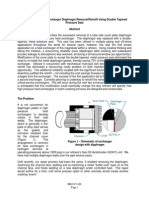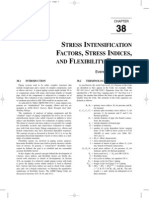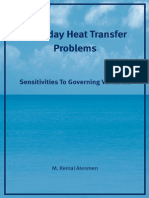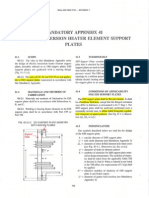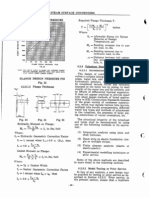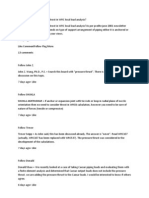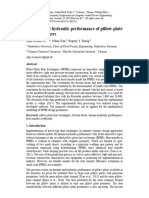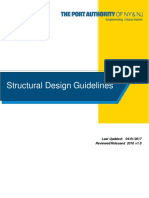0 ratings0% found this document useful (0 votes)
320 viewsLigament Pressure Vessel Analysis
Ligament Pressure Vessel Analysis
Uploaded by
Annie HillFE ANALYSIS OF PRESSURE VESSEL
Copyright:
© All Rights Reserved
Available Formats
Download as PDF, TXT or read online from Scribd
Ligament Pressure Vessel Analysis
Ligament Pressure Vessel Analysis
Uploaded by
Annie Hill0 ratings0% found this document useful (0 votes)
320 views8 pagesFE ANALYSIS OF PRESSURE VESSEL
Copyright
© © All Rights Reserved
Available Formats
PDF, TXT or read online from Scribd
Share this document
Did you find this document useful?
Is this content inappropriate?
FE ANALYSIS OF PRESSURE VESSEL
Copyright:
© All Rights Reserved
Available Formats
Download as PDF, TXT or read online from Scribd
Download as pdf or txt
0 ratings0% found this document useful (0 votes)
320 views8 pagesLigament Pressure Vessel Analysis
Ligament Pressure Vessel Analysis
Uploaded by
Annie HillFE ANALYSIS OF PRESSURE VESSEL
Copyright:
© All Rights Reserved
Available Formats
Download as PDF, TXT or read online from Scribd
Download as pdf or txt
You are on page 1of 8
At a glance
Powered by AI
The paper describes a stress analysis of a nuclear steam generator tubesheet with a thin or irregular ligament associated with a mis-drilled hole.
The paper describes applying the rules of ASME B&PV Section III and Non-Mandatory Appendix A, Article A-8000 for stresses in perforated flat plates to evaluate a tubesheet with a deviation from the nominal hole size/shape.
The methodology used to evaluate structural integrity is described in ASME Appendix A, Article A-8000 for stresses in perforated flat plates. Stress multipliers are applied to calculate stresses and cumulative fatigue usage factors.
1 Copyright 2013 by ASME
ASME SECTION III STRESS ANALYSIS OF A HEAT EXCHANGER TUBESHEET WITH A
MISDRILLED HOLE AND IRREGULAR OR THIN LIGAMENTS
Dr. Enrique Gomez
ENSA Engineering Department
Avda Juan Carlos I, 8, 39600
Maliano, Cantabria, Spain
Tel: +34-942-200166
Email: gomez.enrique@ensa.es
Mr. Roberto Ruiz
ENSA Engineering Department
Avda Juan Carlos I, 8, 39600
Maliano, Cantabria, Spain
Tel: +34-942-200101
Email: ruiz.roberto@ensa.es
Mr. Robert M. (Con) Wilson
Private Consultant
3609 Cherry Hill Drive, Orlando, Florida USA
Tel: 407-761-1337
Email: conwilson1@aol.com
ABSTRACT
A stress analysis is described for a nuclear steam
generator tubesheet with a thin or irregular ligament
associated with a mis-drilled hole using the rules of ASME
B&PV Section III and Non-Mandatory Appendix A, Article
A-8000 for Stresses in Perforated Flat Plates. The analysis
demonstrates the proper application of the NB-3200 rules for
this special application with discussion of the differences
between an actual tube hole deviation from what is assumed in
ASME Appendix A. This is a companion paper to Technical
Justification Supporting Operation with a Tube Installed in a
Mis-Drilled Hole of a Steam Generator Tubesheet
NOMENCLATURE
h = nominal width of ligament at the minimum cross
section, (P d) (inches)
P = nominal distance between hole center lines, pitch
(inches)
t = thickness of plate exclusive of cladding or
corrosion allowance (inches)
! = ligament efficiency = h/P
!* = effective Poissons ratio for perforated plate (Fig.
A-8131-1) [Ref. 3]
E* = effective Youngs modulus for perforated plate
(Fig. A-8131-1) [Ref. 3](ksi)
R* = the effective radius of the perforated plate = r
o
+
1/4 (P - h) (inches)
r
o
= radial distance from center of plate to center of
outermost hole (inches)
p
1
, p
2
=
pressures acting on surfaces of the plate (ksi)
!p = differential pressure across the plate (ksi)
"
r
* = radial stresses in the equivalent solid plate (ksi)
"
#
* = tangential stress in the equivalent solid plate (ksi)
"
a
* = axial stress in the equivalent solid plate (ksi)
"
ra
* = radial-axial shear stress in the equivalent solid
plate (ksi)
"
r
= radial stresses in the tubesheet (ksi)
"
#
= tangential stress in the tubesheet (ksi)
Proceedings of the ASME 2013 Pressure VesseIs and Piping Conference
PVP2013
JuIy 14-18, 2013, Paris, France
PVP2013-97075
2 Copyright 2013 by ASME
$
r
= radial strain in the tubesheet (ksi)
$
#
= tangential strain in the tubesheet (ksi)
% = biaxiality ratio ("
r
/"
"
or "
"
/"
r
) or ("
1
/"
2
or "
2
/"
1
),
where - 1 # % # 1
"
1
*
,
"
2
* = principal stress in the plane of the equivalent solid
plate (A-8142.2) [Ref. 3] (ksi)
"
ave
* = larger absolute value of "
r
* or "
#
* (A-8142.1(b))
[Ref. 3] (ksi)
"
skin
= thermal skin stress (ksi)
d = diameter of holes in the tubesheet (inches)
K = stress multiplier for stresses averaged across the
width of the ligament but not through the
tubesheet thickness (Fig. A-8142-1) [Ref. 3]
Y
1
, Y
2
= stress multipliers for peak ligament stresses (Fig.
A-8142-3 and A-8142-4) [Ref. 3]
Y
max
= stress multipliers given in Fig. A-8142-2 as a
function of biaxiality ratio % [Ref. 3]
K
m
= ratio of total stress in the thin ligament to the total
stress in nominal ligament (Fig. A-8143.2-1) [Ref.
3]
K
skin
= stress multiplier for thermal skin stress (Fig. A-
8153-1) [Ref. 3]
S = stress intensity (A-8142) [Ref. 3] (ksi)
v = Poissons ratio
E = Youngs modulus for tubesheet material (ksi)
E
t
= Youngs modulus for the tube material (ksi)
T
m
= mean temperature averaged through the thickness
of the tubesheet
T
s
= temperature of the secondary surface of the
tubesheet
! = coefficient of thermal expansion
t
t
= tube wall thickness (inches)
p
s
= pressure on surface where stress is computed, p
1
or p
2
(ksi)
p
1
= pressure in the primary side (ksi)
p
2
= pressure in the secondary side (ksi)
p
i
= pressure inside tubes (ksi)
P
m
= primary membrane stress (ksi)
P
m+b
= primary membrane plus bending stress (ksi)
Q
= secondary stress (ksi)
F = peak stress (ksi)
CUF = cumulative usage factors for fatigue
INTRODUCTION
Perforated plate stress analysis has been performed for
decades using a methodology that was established in the early
1960s [Ref. 1]. That methodology was introduced to the
ASME Boiler and Pressure Vessel Code for Nuclear
Components (Section III) in the Summer 1966 Addenda to the
1965 Edition as non-mandatory Appendix I, Article I-9
Stresses in Ligaments [Ref. 2]. This same methodology is
present, with minor editorial changes, in the current 2011
Addenda of the 2010 Edition of Section III as Appendix A,
Article A-8000 [Ref.3]. This methodology allows the
tubesheet to be analyzed as if it is a solid plate followed by the
application of stress multipliers that were derived from
experiments as a function of the tube hole size and pitch. The
conversion of a plate with drilled holes to an equivalent solid
plate is accomplished by using a modified Youngs modulus
and Poissons ratio that is based on tests of plates with various
tube hole diameter-to-pitch ratios or ligament efficiencies.
The original methodology also included a procedure for
evaluating stresses for a mis-drilled hole with a thinner than
nominal ligament. The mis-drilled hole configuration assumed
that the hole was out-of-position through the entire thickness
of the tubesheet, i.e. parallel to the neighboring holes.
The stress analysis described in this paper is based on the
more realistic as-fabricated condition where the mis-drilled
hole is not parallel to the neighboring holes. In this case, the
drilling of the hole begins at the appropriate position and then
drifts away from the intended path, to exit the opposite side of
the tubesheet with an out-of-position condition. The limiting
location for this condition is at the thinnest ligament location.
The structural analysis of the tubesheet, channel head,
lower shell complex involves several simplifications. This
paper discusses some of them.
GEOMETRY OF THE TUBESHEET
Figure 1 shows the dimensions of an axisymmetric model
of a typical steam generator tubesheet, channel head and lower
shell configuration. All parts are constructed using SA-508,
Grade 3, Class 2 low alloy steel. The tubesheet that is modeled
has 14,440, 0.75-inch diameter holes for 7,220 U-tubes. For
simplicity, the tube outer diameter is assumed to be equal to
the hole diameter. The distance between holes (the tube pitch)
is 1 inch and the holes are arranged in an equilateral triangular
pattern. This produces a 0.25-inch nominal, minimum
ligament between holes. The ligament efficiency [! = (P-d)/P
= h/P] is 0.25. The tubes in the tubesheet holes are Alloy 690
material and have a t
t
= 0.040-inch wall thickness.
The actual tubesheet has a hot leg side where the heated
reactor coolant enters the steam generator tube bundle. The
hot leg side has 7,220 holes, each containing the hot leg end of
the 7,220 U-bend tubes. The U-bend tubes transfer heat from
the reactor coolant to the secondary side fluid to produce
steam, and the reactor coolant exits the bundle through the
cold leg side of the tubesheet. The hot leg and cold leg sides of
the tubesheet are separated by a non-drilled (solid) tubelane
that extends across the full diameter of the tubesheet. The
steam generator also has a solid divider plate that joins the
tubesheet to the channel head and forces the hot reactor
coolant to flow through the U-tubes.
It is possible to evaluate the tubesheet stresses using a 3D
finite element model that contains the non-perforated tubelane
and the divider plate. However, since the original equivalent
solid plate methodology is based on an axisymmetric
structure, it is acceptable to treat the pressure boundary as
being axisymmetric assuming the entire tubesheet to be
perforated (neglecting the tubelane and divider plate).
The location of the mis-drilled hole used in this analysis is
shown in Figure 2.
3 Copyright 2013 by ASME
Figure 1. Tubesheet, Channel Head, Lower Shell Geometry
Figure 2. Location of the Mis-Drilled Hole
The mis-drilled hole is located 42.73-inches from the
center of the tubesheet (on the primary side) where the
nominal primary side ligament is 0.25-inch. The secondary
side ligament is assumed to be 0.1-inch. The mis-drilled hole
geometry is shown in Figure 3.
Figure 3. Geometry of the Mis-Drilled Hole
STRESS EVALUATION NOMINAL LIGAMENT
ASME Section III Appendix A, Article A-8000 [Ref. 3]
provides a methodology for determining stresses in perforated
plates. This methodology first calculates the ligament stresses
at a nominal ligament and then modifies the result to account
for an irregular or thin ligament. Following is a discussion of
the stress analysis of the nominal ligament at the radial
position of the mis-drilled hole (i.e. DS1 in Figure 1).
The tubesheet loadings used in this example include
pressure differences and thermal differences for 10 transient
events across the tubesheet thickness. The metal temperature
in the perforated region of the tubesheet is equal to the tube
inside temperature (either reactor coolant hot leg temperature
or cold leg temperature) through most of the tubesheet
thickness, with the exception of a thin zone at the secondary
face where secondary side water cools the tubesheet. The
tubesheet surface stresses caused by this local cooling are
called thermal skin stresses.
Additional thermal stresses are produced by the thermal
interaction between the tubesheet perforated region and the
adjacent, non-perforated part of the tubesheet and the attached
channel head, and lower shell. These thermal stresses are
called gross thermal interaction stresses.
The pressure induced stresses and the gross thermal
interaction stresses are calculated using an ANSYS [Ref. 5]
finite element model based on the equivalent solid plate
properties as defined by A-8130 [Ref. 3]. The secondary side
surface temperatures are calculated using the finite element
model; but the skin stress is not. The thermal skin stress is
calculated using the equation from A-8153 [Ref. 3]. This is
4 Copyright 2013 by ASME
consistent with the recommendations of Slot and ODonnell
[Ref. 4 and Ref. 1].
The tubesheet stress results at the secondary side location
labeled DS1 in Figure 1 are shown in Table 1 for a unit
pressure loading (1000 psi).
Table 1. Tubesheet Pressure Stresses due to Unit Loads
Membrane, Pm
@ Sec. Side Node
#
r
*
(ksi)
#$*
(ksi)
#
a
*
(ksi)
"
ra
*
(ksi)
p1 = 1 ksi 0.281 0.261 -0.511 0.710
p2 = 1 ksi 0.008 -0.011 -0.509 -0.710
Mem+Bend, Pm+b
@ Sec. Side Node
#
r
*
(ksi)
#$*
(ksi)
#
a
*
(ksi)
"
ra
*
(ksi)
p1 = 1 ksi 1.541 2.424 -0.005 0.710
p2 = 1 ksi -1.389 -2.311 -0.996 -0.710
THERMAL SKIN STRESS EVALUATION
The thermal skin stress is calculated using equation (24)
from A-8153 [Ref. 3]; "
rskin
= "
#skin
= E % (T
m
T
s
) / (1-&).
A-8153 tells the analyst to use equation (23); "
skin
= K
skin
Y
max
(P/h) E % (T
m
T
s
) / (1-&) when equation (24) was intended.
The ASME acknowledged this editorial error in response to a
2012 code inquiry [Ref. 6].
The secondary side tubesheet metal surface temperature
T
s
is calculated by ANSYS for each transient and the tubesheet
mean temperature, T
m
, is set equal to the average temperature
in the tubesheet, which is the reactor coolant hot leg
temperature for purposes of this analysis.
The thermal skin stress is not dependent on the ligament
efficiency because the skin effect is localized near the surface
of a very thick plate. The thick plate constrains the secondary
surface so that its in-plane surface strains $
r
and $
#
are zero.
This assumption leads to the thermal skin stress equation:
"
rskin
= "
#skin
= E % (T
m
T
s
) / (1-&). Paragraph A-8153.1
equation (24) [Ref. 3] incorporates a stress reduction factor,
K
skin
based on the nominal ligament efficiency (& = 0.25) for
the purpose of adjusting the thermal skin stress so it can be
combined with the stresses from all of the other load cases
using the equivalent solid plate method. Table 2 shows the
thermal skin stresses for 'T = (T
m
T
s
) = 100F. Thermal skin
stress is classified as peak stress (F).
Table 2. Thermal Skin Stresses for 100
o
F "T
Thermal Peak, F
Sec. Side Node
#
r
*
(ksi)
#$*
(ksi)
#
a
*
(ksi)
"
ra
*
(ksi)
'T = 100F 5.823 5.823 0.0 0.0
TUBE INTERNAL PRESSURE LIGAMENT STRESSES
A-8110 (b) [Ref. 3] acknowledges that the tubes stiffen
the tubesheet. Nuclear steam generator tubes are expanded full
depth into the tubesheet holes increasing the tubesheet
stiffness. This effect is conservatively ignored in this analysis;
but could be included if needed to confirm structural
acceptability.
The influence of the pressure loading inside the tubes is
included because it produces membrane stresses in the
tubesheet ligaments. This effect is addressed in equation (13)
of A-8132.4 [Ref. 3]. This equation incorporates a stress
reduction factor, h/P that adjusts the stresses due to the tube
internal pressure so they can be combined with the stresses
from the other load cases that are based on the equivalent solid
plate properties. The ratio of Young's modulus for the tube
(E
t
) to the Young's modulus of the tubesheet material (E) is
included to account for the different properties of the tube and
the tubesheet ligament. The ligament stresses due to tube
internal pressure are listed in Table 3.
Table 3. Ligament Membrane Stress due to Tube Internal
Pressure (Unit Load Case)
Membrane, Pm
Sec. Side Node
#
r
*
(ksi)
#$*
(ksi)
#
a
*
(ksi)
"
ra
*
(ksi)
p
i
= 1 ksi 0.497 0.497 0.0 0.0
PRIMARY STRESS EVALUATION
The NB-3221.1 primary membrane stress intensity
requirement [Ref. 7] is to be satisfied based on the stresses due
to mechanical and pressure loads. The membrane stress is
averaged across the nominal ligament width (0.25-inch) and
across the tubesheet thickness as required by A-8142.1 (a)
[Ref. 3].
Using the membrane values of Tables 1 and 3, the radial
stress, averaged through the depth of the equivalent solid plate
for DS1, and the larger value of equation (16) and (17) [Ref.
3] is calculated in Table 4.
Table 4. Primary Membrane Stress
Membrane, Pm
@ Sec. Side Node
p1 = pi
(ksi)
p2
(ksi)
#r*
(ksi)
S
(ksi)
Limit
(ksi)
Design 2.500 0.900 1.952 12.003 30.000
Level A & B 2.700 0.800 2.107 13.719 33.000
Level C 2.600 0.000 2.023 16.879 48.510
Level D 2.800 0.000 2.178 18.177 63.000
Test 3.100 0.000 2.412 20.125 54.140
The NB-3221.3 primary membrane plus bending stress
intensity requirement [Ref. 7] is to be satisfied based on the
stresses due to mechanical and pressure loads. The stresses at
the surface of the tubesheet are averaged across the nominal
ligament width (0.25-inch) as required by A-8142.1 (b) [Ref.
3].
Using the membrane plus bending values of Table 1 and
membrane of Table 3, the radial and hoop stresses for DS1 is
calculated in Table 5 according to equation (18) [Ref. 3]:
S = K (P/h) #
ave
* (1)
5 Copyright 2013 by ASME
Table 5. Primary Membrane plus Bending Stress
Mem+Bend
Sec. Side Node
#r*
(ksi)
#$*
(ksi)
( K
S
(ksi)
Limit
(ksi)
Pm+b
Design 3.845 5.223 0.74 1.01 21.099 45.000
Level A & B 4.391 6.038 0.73 1.01 24.393 49.500
Level C 5.299 7.595 0.70 1.01 30.682 72.765
Level D 5.706 8.179 0.70 1.01 33.042 94.500
Test 6.318 9.055 0.70 1.01 36.583 81.210
PRIMARY + SECONDARY STRESS RANGE
The NB-3222.2 primary plus secondary stress intensity
range requirement [Ref. 7] is to be satisfied based on the
stresses due to mechanical, pressure, and the gross thermal
interaction loads. The stresses at the surface of the tubesheet
are averaged across the nominal ligament width (0.25-inch) as
required by A-8142.2 (a) [Ref. 3].
Using the membrane plus bending values of Table 5 and
the gross thermal stresses, the radial and hoop stress for DS1
is calculated in Table 6 according to equation (19) [Ref. 3]:
S = K (P/h) #
1
* (2)
Table 6. Primary plus Secondary Stress Range
@ Secondary
Side Node
Gross Thermal, Qm+b
p
1
= p
i
(ksi)
p
2
(ksi)
Pm+b + Qm+b
#
r
*
(ksi)
#$*
(ksi)
#
r
(ksi)
#$
(ksi)
Transient 1 0.000 0.000 0.000 0.000 0.000 0.000
Transient 2 0.085 0.083 2.224 1.066 12.546 16.461
Transient 3 -0.327 -0.326 2.250 0.796 12.612 17.627
Transient 4 -0.137 -0.137 2.203 0.751 13.235 18.245
Transient 5 1.771 1.753 1.546 1.106 13.538 14.845
Transient 6 1.030 1.009 1.917 0.403 17.507 22.706
Transient 7 2.990 2.962 1.605 0.865 20.236 22.598
Transient 8 -0.108 -0.109 2.227 1.053 11.875 15.855
Transient 9 0.000 0.000 3.100 0.000 25.271 36.220
Transient 10 0.000 0.000 0.000 1.500 -8.334 -13.866
( = 0.67 Max. Range = 33.605 50.086
K = 1.02 Max. Range = 51.088 ksi
PEAK STRESS INTENSITY AND FATIGUE
The peak stress intensity due to all loadings is limited by
the NB-3222.4 cyclic fatigue requirement [Ref. 7]. The total
stresses at the surface of the tubesheet at the nominal ligament
are calculated as required by A-8142.2 (b) or (c) [Ref. 3]. A-
8142.2 (b) and (c) both deal with the calculation of the peak
stress intensity; but equation (20); S = Y
max
(P/h) #
1
*+ p
s
,
is
only intended for loadings where the maximum stress intensity
angular orientation is constant.
In most practical cases (and the example of this paper) the
bi-axiality ratio (%) for pressure stresses and thermal stresses
are different and vary during the transient history, and the
principal stress angular orientations change during the
transient history so Equation (21); S
'
= Y
1
"
1
*/& + Y
2
"
2
*/& +
p
s
used.
In 2012 the ASME Section III Code Interpretations
Committee ruled that the label (c) was an editorial error
[Ref. 6] thus confirming that both equations (20) and (21)
[Ref. 3] were intended as alternatives.
The peak stress intensity around the periphery of the hole
at location DS1 is provided by Equation (21) of paragraph A-
8142.2 (c) [Ref. 3]. The angular orientation of the mis-drilled
hole to the tubesheet drilling pattern (angle ') must be
determined so that the stress multipliers from Figs. A-8142-3
and A-8142-4 can be determined. Following is Equation (21)
from Reference 3.
S
'
= Y
1
"
1
*/& + Y
2
"
2
*/& + p
s
(3)
where:
S
'
= peak stress intensity at the angular orientation '
Y
1
, Y
2
= stress multipliers in Figs. A-8142-3 and 4.
Figures A-8142-3 and A-8142-4 are used because they
most closely match the angular orientation of the holes at
DS1 (see Figure 4) where the angle is 5.8 from the actual
radial orientation (for this location "
2
), which is less than
the 7.5 value of applicability
& = nominal ligament efficiency (0.25)
"
1
*, "
2
* = the principal stresses in the plane of the
equivalent solid plate, based on all loadings (except the
ligament stresses due to the pressure in the tubes
(equation (13)[Ref. 3]).
For angles '=30 and '=90 the ligament stresses due to
the pressure in the tubes have the maximum values per
equation (13)[Ref. 3] without any stress concentration factor
because it is calculated based on the real geometry (see Figure
5).
Figure 4. Relative Location of the Deviated Hole respect to the
Radial Orientation
6 Copyright 2013 by ASME
( ) ( )
2! ! ! 2!
!
2! ! ! 2! !
t i t t
r i
t t
t t
d t p t P h t
F
p
E E A
h t t h t
E E
!
" "
# # #
= = = =
$ % $ %
+ +
& ' & '
( ) ( )
(4)
Figure 5. Equation (13) [Ref. 3] to be added to S
'
of Equation
(21) [Ref. 3]
The peak stress intensity is determined for all time steps
of all transients for the fatigue evaluation.
The total stress results at location DS1 are listed in Table
7. Table 8 shows the stress intensity calculated using equation
(21)[Ref. 3] for two representative angles around the hole, 0
and 90. Finally, Table 9 shows the factors from Figures A-
8142-3 and A-8142-4 [Ref. 3] and the cumulative usage
factors for nominal ligament.
Table 7. Total Stresses - Nominal Ligament
Total Stress
@ Sec. Side Node
p
1
= p
i
(ksi)
p
2 = p
s
(ksi)
'T
(
o
F)
#2* = #
r
*
(ksi)
#1* = #$*
(ksi)
(P+Q+F)
m+b
Transient 1 0.000 0.000 0 0.000 0.000
Transient 2 2.224 1.066 91 7.319 8.297
Transient 3 2.250 0.796 92 7.409 8.663
Transient 4 2.203 0.751 93 7.618 8.870
Transient 5 1.546 1.106 -167 -7.114 -6.787
Transient 6 1.917 0.403 -117 -3.389 -2.089
Transient 7 1.605 0.865 -239 -9.673 -9.082
Transient 8 2.227 1.053 93 7.283 8.278
Transient 9 3.100 0.000 0 4.777 7.514
Transient 10 0.000 1.500 0 -2.084 -3.467
Table 8. Peak Stress Intensity at 0 & 90, Nominal Ligament
Total Stress
@ Sec. Side Node
Cycles
S
'=0
(ksi)
S
'=90
(ksi)
Transient 1 400 0.000 0.000
Transient 2 6,000 22.128 43.850
Transient 3 6,000 20.699 45.370
Transient 4 200 21.411 46.184
Transient 5 10 -26.269 -26.977
Transient 6 50 -18.816 -5.136
Transient 7 15 -37.148 -37.606
Transient 8 1,000,000 21.899 43.759
Transient 9 10 2.416 41.277
Transient 10 10 1.468 -14.723
Table 9. Stress Multipliers and CUF - Nominal Ligament
Angle Y1 Y2 CUF
0 -1.35 2.25 0.0015
10 -1.15 2.15 0.0027
20 -0.6 1.75 0.0055
30 0.3 0.8 0.0076
40 1.05 0 0.0065
50 1.4 -0.4 0.0062
60 1.3 -0.47 0.0033
70 1.25 -0.27 0.0055
80 1.22 -0.15 0.0072
90 1.2 -0.05 0.0124
STRESS EVALUATION THIN LIGAMENT
Table NB-3217-1 [Ref. 7] classifies the stress intensities
at an isolated or atypical ligament (such as that found next to a
mis-drilled hole). It states that membrane stress due to
pressure is classified as secondary (Q) and bending is
classified as peak (F). This means that the mis-drilled hole
does not change the tubesheet primary stress margins for the
Design Condition, Service Levels A, B, C and D, and / or the
Test Condition for the tubesheet with nominal ligaments. The
Triaxial stress requirement is also satisfied because it is based
on primary stresses.
The stress limits that must be satisfied at an irregular or
thin ligament are found in paragraph A-8143 [Ref. 3]. A-8143
requires evaluation of the Average Stress Intensity at the mid-
surface of the tubesheet (A-8143.1) and Peak Stress Intensity
(fatigue) (A-8143.2) at the tubesheet surface.
AVERAGE STRESS INTENSITY LIMIT (A-8143.1)
Paragraph A-8143.1 limits the average ligament stress
intensity due to pressure plus other mechanical loads to 3.0S
m
.
The gross thermal discontinuity stresses should also be
included (although not mentioned). This is consistent with the
original work of ODonnell [Ref. 1] in his discussion of the
thin ligament and is consistent with the definition of secondary
stresses. This stress intensity is based on stresses averaged
across the thin ligament width and averaged across the
tubesheet thickness (thus removing bending). This evaluation
is similar to that performed to evaluate primary membrane in
A-8142.1 (a) except that the actual width of the thin ligament
(h
a
) is used in place of the nominal width h. The membrane
stress components from the equivalent solid plate for the
nominal ligament that were multiplied by the P/h ratio are
changed using the P/h
a
ratio for the actual thin ligament.
The A-8143.1 methodology [Ref. 3] is based on the
conservative assumption that a mis-drilled hole is parallel to
its neighbors and that the actual thin ligament extends through
the entire tubesheet thickness. Since actual mis-drilled holes
are not typically parallel to the neighboring holes, it is
necessary to determine the ligament width at the tubesheet
mid-surface, h
m
and to use it in the A-8143.1 evaluation. A
linear variation in the ligament thickness is conservative for
typical mis-drilled holes. Using this assumption, the actual
mid-surface ligament for use in the A-8143.1 evaluation is h
m
= (h + h
a
) / 2. The average stress intensity results for the
irregular or thin ligament are shown in Table 10. All values
are less than the allowable 3S
m
(90 ksi) value.
7 Copyright 2013 by ASME
Table 10. Primary plus Secondary Stresses - Thin Ligament
Gross Thermal
p1 = pi
(ksi)
p2
(ksi)
#r
(ksi)
#$
(ksi)
@ Secondary
Side Node
#r*
(ksi)
#$*
(ksi)
Qm+b Pm + Qm+b
Transient 1 0.000 0.000 0.000 0.000 0.000 0.000
Transient 2 0.085 0.083 2.224 1.066 10.057 9.684
Transient 3 -0.327 -0.326 2.250 0.796 9.572 9.230
Transient 4 -0.137 -0.137 2.203 0.751 9.632 9.299
Transient 5 1.771 1.753 1.546 1.106 9.451 9.129
Transient 6 1.030 1.009 1.917 0.403 10.012 9.719
Transient 7 2.990 2.962 1.605 0.865 11.445 11.127
Transient 8 -0.108 -0.109 2.227 1.053 9.795 9.424
Transient 9 0.000 0.000 3.100 0.000 13.782 13.427
Transient 10 0.000 0.000 0.000 1.500 0.069 -0.094
( = 0.99 Max. Range = 13.713 13.522
K = 1.00 Max. Range = 13.713 ksi
PEAK STRESS INTENSITY LIMIT (A-8143.2)
Paragraph A-8143.2 [Ref. 3] describes the method for
obtaining the peak stress intensity for a thin ligament. The thin
ligament peak stress intensity is computed by multiplying the
nominal peak stress intensity (for the nominal ligament) by the
K
m
value from Figure A-8143.2-1 [Ref. 3]. The K
m
minimum
ligament multiplier and the peak stress intensity are calculated
at each transient load step. The stresses from all of the
loadings (i.e. pressure, gross thermal stresses, skin stresses)
are superimposed at each load step to determine the ratio of
the two principal stresses (the bi-axiality ratio, %). Then a
value for K
m
is extracted from Figure A-8143.2-1 [Ref. 3] by
linear interpolation between the two nearest plotted % values
(either % = -1, 0, or +1).
Paragraph A-8143.2 (a) states that the peak stress
intensity in the nominal ligament is calculated as indicated in
A-8142.2 (b). As written, this cross-reference could be
interpreted to exclude the use of the A-8142.2 (c) to calculate
the peak stress intensity, but such an interpretation was not
intended. This incomplete cross-reference was not present in
the original text of the 1966 Addenda [Ref. 2] when it was
first introduced. The ASME Section III Committee for Code
Interpretations confirmed that this was an editorial error that
will be corrected in a future code edition [Ref. 6].
PEAK STRESS INTENSITY EVALUATION
Equation (21) [Ref. 3] is modified to account for the thin
ligament by multiplying the total stress for the nominal
thickness ligament by the K
m
value from Figure A-8143.2-1
[Ref. 3]. Therefore the modified Equation (21) appears as
follows:
S
'-thin
= (Y
1
"
1
*/& + Y
2
"
2
*/&)K
m
+ p
s
(5)
The peak stress intensities are calculated for each of the
transient stress states considered in the fatigue evaluation.
Special consideration is required for angles '=30 and
'=90. In these angles the ligament stresses due to the
pressure in the tubes have the maximum values and it is added
(equation (13)[Ref. 3]) without any stress concentration factor
because it is calculated in the real geometry. For other angle,
this stress can be considered negligible (see Figure 5).
Therefore, for the thin ligament:
S
'-thin
(30&90) =
( )
* *
1 1 2 2
2! !
2! !
t i
m s
t
m t
d t p Y Y
K p
E
h t
E
! !
"
# $ % +
+ +
& '
$ %
( )
+
& '
( )
(6)
Tables 11, 12 and 13 show the result of the process to obtain
the Stress Intensity and Cumulative Usage Factors for Fatigue
in a thin or irregular ligament.
Table 11. Total Stress - Thin Ligament
Total Stress
(P+Q+F)
m+b
Sec. Side Node
#2* = #r*
(ksi)
#1* = #$*
(ksi)
( Km
Transient 1 0.000 0.000 0.00 2.50
Transient 2 7.319 8.297 0.88 2.06
Transient 3 7.409 8.663 0.86 2.07
Transient 4 7.618 8.870 0.86 2.07
Transient 5 -7.114 -6.787 0.95 2.02
Transient 6 -3.389 -2.089 0.62 2.19
Transient 7 -9.673 -9.082 0.94 2.03
Transient 8 7.283 8.278 0.88 2.06
Transient 9 4.777 7.514 0.64 2.18
Transient 10 -2.084 -3.467 0.60 2.20
Table 12. Peak Stress Intensity at 0 and 90 - Thin Ligament
Total Stress
@ Sec. Side Node
Cycles
S
'-thin=0
(ksi)
S
'-thin=90
(ksi)
Transient 1 400 0.000 0.000
Transient 2 6,000 44.433 85.736
Transient 3 6,000 42.042 89.648
Transient 4 200 43.530 91.385
Transient 5 10 -54.272 -57.972
Transient 6 50 -41.720 -15.193
Transient 7 15 -76.321 -79.628
Transient 8 1,000,000 43.998 85.601
Transient 9 10 5.272 84.543
Transient 10 10 1.429 -34.181
Table 13. Stress Multipliers and CUF - Thin Ligament
Angle Y1 Y2 CUF
0 -1.35 2.25 0.0226
10 -1.15 2.15 0.0336
20 -0.6 1.75 0.0595
30 0.3 0.8 0.0767
40 1.05 0 0.0722
50 1.4 -0.4 0.0705
60 1.3 -0.47 0.0413
70 1.25 -0.27 0.0638
80 1.22 -0.15 0.0795
90 1.2 -0.05 0.1088
The results of the analysis for the nominal 0.25 tubesheet
ligament are compared to those of the thin 0.10 ligament in
Table 14. This comparison shows that the mis-drilled hole
does not impact the primary plus secondary stress intensity
range because of the different classification of stresses in a
single, thin ligament (per Table NB-3217-1 [Ref. 7]). The
8 Copyright 2013 by ASME
main influence of the mis-drilled hole is to increase the
cumulative fatigue usage factor.
Table 14. Nominal vs. Thin Ligament Results
ASME Section III Code Limit
Nominal
(0.25 in.)
Ligament
Thin
(0.10 in.)
Ligament
Primary + Secondary Stress Intensity Range 51.088 ksi 13.713 ksi
Cumulative Fatigue Usage Factor, CUF 0.0124 0.1008
CONCLUSIONS
The methodology used to evaluate the structural integrity
of a steam generator tubesheet with a mis-drilled hole is
described and explained. The non-mandatory rules of ASME
Appendix A, Article A-8000 [Ref. 3] contains several
ambiguities that are addressed and clarified. The analysis is
applied to an actual, non-parallel mis-drilled hole and
compared to a parallel mis-drilled hole as is assumed in
Appendix A. It is shown that the main influence of a mis-
drilled hole is on the cumulative fatigue usage factor.
This method does not account for load redistribution
around a thin ligament so the fatigue result is conservative.
The presence of mis-drilled holes or locally thin ligaments do
not affect the primary stress margin in the tubesheet and do
not reduce its overall structural integrity. Therefore, there is no
consequence of a fatigue crack at any point within the
tubesheet drilling-pattern because it could not propagate
beyond the local ligament. Consequently, the presence of mis-
drilled holes within the tubesheet drilling pattern, although it
may complicate tube installation, is a structurally acceptable
condition.
ACKNOWLEDGMENTS
The authors would like to acknowledge the contribution
of Equipos Nucleares S.A. (ENSA) and Enrique Casado in the
development of this report.
REFERENCES
1. W. J. ODonnell, B. F. Langer, Design of Perforated
Plates, ASME Paper No. 61-WA-115, Journal of Engineering
for Industry, Transactions of the ASME, Vol. 84, August 1962
2. ASME Boiler & Pressure Vessel Code, Section III,
Rules for Construction of Nuclear Power Plant Components,
1965 Edition with Addenda through Summer 1966, Appendix
I, Article I-9 Stresses in Ligaments, The American Society
of Mechanical Engineers, New York, New York
3. ASME Boiler & Pressure Vessel Code, Section III,
Rules for Construction of Nuclear Power Plant Components,
2010 Edition, 2011 Addenda, Division 1 Appendices,
Appendix A, Article A-8000 Stresses in Perforated Flat
Plates, The American Society of Mechanical Engineers, New
York, New York
4. Thomas Slot, Stress Analysis of Thick Perforated
Plates, Technomic Publishing Co. Inc, Westport, CT 1972
5. ANSYS Computer Program Release 10.0 A1, ANSYS
Inc., South Point, 275 Technology Dr., Canonsburg, PA
15317.
6. ASME Code Inquiry File: 12-1333, Letter from Ms.
Allyson Byk, Secretary, Section III Standards Committee to
inquirer Robert Wilson, August 22, 2012
7. ASME Boiler & Pressure Vessel Code, Section III,
Rules for Construction of Nuclear Power Plant Components,
2010 Edition, 2011 Addenda, Subsection NB, The American
Society of Mechanical Engineers, New York, New York
You might also like
- PVP2008-Hinnant and PaulinDocument50 pagesPVP2008-Hinnant and PaulinFeliper65No ratings yet
- Dupont Design of Trunnions 1979Document26 pagesDupont Design of Trunnions 1979mjjanowski100% (1)
- R 015987Document63 pagesR 015987shaffeti100% (2)
- Stiffness Coefficients For Nozzles in API 650 Tanks PDFDocument8 pagesStiffness Coefficients For Nozzles in API 650 Tanks PDFvijay10484100% (1)
- Journal of Pressure Vessel Technology VolumeDocument4 pagesJournal of Pressure Vessel Technology VolumeMukil DevNo ratings yet
- Correlation Between Pipe Bend Geometry and Allowable Pressure in Pipe Bends Using Artificial Neural Network PDFDocument13 pagesCorrelation Between Pipe Bend Geometry and Allowable Pressure in Pipe Bends Using Artificial Neural Network PDFshyfxNo ratings yet
- Stress Analysis of TEEDocument7 pagesStress Analysis of TEEEPCFirmNo ratings yet
- PD CEN-TR 15728 2008 Inserts For Lifting and Handling Precast ElementsDocument54 pagesPD CEN-TR 15728 2008 Inserts For Lifting and Handling Precast Elementsdicktracy11100% (1)
- Csi Bridge BSD Aashto LRFD 2014Document219 pagesCsi Bridge BSD Aashto LRFD 2014ev xvNo ratings yet
- Stress Analysis and Design of Bolted Flange Connections UnderDocument11 pagesStress Analysis and Design of Bolted Flange Connections UndervijaygalaxyNo ratings yet
- SIF's For TrunnionDocument10 pagesSIF's For TrunnionfileseekerNo ratings yet
- 5 External Flange Loads and Koves Method by DekkerDocument11 pages5 External Flange Loads and Koves Method by DekkerSharat ChandraNo ratings yet
- Diaphragm Elimination Using Taper-Lok - NPRADocument11 pagesDiaphragm Elimination Using Taper-Lok - NPRAN. S. PanditNo ratings yet
- Summary and Applications of The New Fatigue Rules in Part 14 of Api 579-1/ASME FFS-1 AND WRC 550Document11 pagesSummary and Applications of The New Fatigue Rules in Part 14 of Api 579-1/ASME FFS-1 AND WRC 550dddNo ratings yet
- Stress Classification TechniqueDocument12 pagesStress Classification TechniqueAndrew FerrierNo ratings yet
- ASME Ch38 p001-018 11-8-08Document18 pagesASME Ch38 p001-018 11-8-08Dan MorganNo ratings yet
- Minimze Leakage in HX Grith Flange PDFDocument5 pagesMinimze Leakage in HX Grith Flange PDFRajesh KumarNo ratings yet
- Design of Flange JointDocument14 pagesDesign of Flange Jointmichal_lysy100% (2)
- Multi Layer Pressure VesselsDocument8 pagesMulti Layer Pressure VesselsprivatehomeNo ratings yet
- Analysis of Flange Joints Under External Loads: W. J. KovesDocument5 pagesAnalysis of Flange Joints Under External Loads: W. J. KovesVilas Andhale100% (1)
- Curso ASMEDocument123 pagesCurso ASMEEduardo DepiattiNo ratings yet
- Analysis of Bolted JointDocument9 pagesAnalysis of Bolted Jointmario_gNo ratings yet
- ASME 2286-2 Alternative Rules For Determining Allowable External PressureDocument16 pagesASME 2286-2 Alternative Rules For Determining Allowable External PressureMike Dukas100% (1)
- PVP2017-66086 Trunnion ElbowsDocument9 pagesPVP2017-66086 Trunnion ElbowsshaffetiNo ratings yet
- Expanded and WeldedDocument9 pagesExpanded and Weldedmasaminathan100% (1)
- WRC 107Document2 pagesWRC 107mit1111chinNo ratings yet
- Heat Transfer Problem 2014Document240 pagesHeat Transfer Problem 2014arminNo ratings yet
- Accuracy of Stress Intensification Factors For Branch ConnectionsDocument48 pagesAccuracy of Stress Intensification Factors For Branch ConnectionsSachin ChavanNo ratings yet
- PIP VESHP001-Mar. 2017 Hairpin Heat Exchanger SpecificationDocument17 pagesPIP VESHP001-Mar. 2017 Hairpin Heat Exchanger SpecificationAlina Paula OpreaNo ratings yet
- Classification of Shell Stresses Resulting From Piping Nozzle LoadsDocument4 pagesClassification of Shell Stresses Resulting From Piping Nozzle LoadsozkanhasanNo ratings yet
- Nagata 2015Document5 pagesNagata 2015FelipeNo ratings yet
- Appendix 41Document5 pagesAppendix 41Rafael_YevgenyNo ratings yet
- Previews ASME 802694 PreDocument51 pagesPreviews ASME 802694 PreTorus EngenhariaNo ratings yet
- Selecting The Optimum Bolt Assembly Stress Influence of Flange Type On Flange Load LimitDocument7 pagesSelecting The Optimum Bolt Assembly Stress Influence of Flange Type On Flange Load LimitMohammed EljammalNo ratings yet
- Asme - Stress Classification Lines Straight Through SingularitiesDocument10 pagesAsme - Stress Classification Lines Straight Through SingularitiesRay FaiersNo ratings yet
- HEI Surface Condenser Tubesheet Design MethodDocument7 pagesHEI Surface Condenser Tubesheet Design Methodm5416100% (1)
- Use Gasket Factor in CalculationDocument7 pagesUse Gasket Factor in CalculationloqNo ratings yet
- Astm A765 PDFDocument4 pagesAstm A765 PDFCristian OtivoNo ratings yet
- LTCS Minus29 Sa105 234 106Document2 pagesLTCS Minus29 Sa105 234 106DIVAKAR PANIGRAHINo ratings yet
- Interpretation VIII 1-16-85Document1 pageInterpretation VIII 1-16-85Prashant Rane100% (1)
- Chapter b04 Stress Analysis of Piping System PDFDocument108 pagesChapter b04 Stress Analysis of Piping System PDFrogel_ganaNo ratings yet
- Ch6 Thermal Stress Analysis Sp16Document34 pagesCh6 Thermal Stress Analysis Sp16Haidar YafieNo ratings yet
- PVP2014-28729 Large Openings in Cylindrical Pressure Vessels-An Assessment Based On Absolute Size 2014 PDFDocument6 pagesPVP2014-28729 Large Openings in Cylindrical Pressure Vessels-An Assessment Based On Absolute Size 2014 PDFmatteo_1234No ratings yet
- Seipp 2014Document5 pagesSeipp 2014Andres VallebellaNo ratings yet
- Flange Leakage CheckingDocument2 pagesFlange Leakage Checkingjaivasanth meNo ratings yet
- BREE J - Elastic-Plastic Behaviour of Thin Tubes Subjected To Internal PressureDocument14 pagesBREE J - Elastic-Plastic Behaviour of Thin Tubes Subjected To Internal PressureFrontonioNo ratings yet
- Mitered Elbow Fea ReportDocument45 pagesMitered Elbow Fea ReportMinh Hong PhamNo ratings yet
- Decoding Pressure Vessel DesignDocument7 pagesDecoding Pressure Vessel Designejzuppelli8036100% (2)
- WRC Load AnalysisDocument5 pagesWRC Load Analysisyogacruise100% (1)
- PVP2006-ICPVT-11-94028: Comparison of Design by Analysis MethodsDocument7 pagesPVP2006-ICPVT-11-94028: Comparison of Design by Analysis MethodsarunNo ratings yet
- Interpreting FEA Stresses - Primary or Secondary - Boiler and Pressure Vessel Engineering - Eng-TipsDocument4 pagesInterpreting FEA Stresses - Primary or Secondary - Boiler and Pressure Vessel Engineering - Eng-TipsAnonymous UoHUagNo ratings yet
- PVP2004-2365 Brown Efficient AssemblyDocument6 pagesPVP2004-2365 Brown Efficient AssemblyOliver KrausNo ratings yet
- Assessment Protocol For Nozzle Loads On Pressure VesselsDocument5 pagesAssessment Protocol For Nozzle Loads On Pressure VesselsBramJanssen76No ratings yet
- Tubesheet PDFDocument8 pagesTubesheet PDFRitesh VishambhariNo ratings yet
- Design of Perforated PlatesDocument13 pagesDesign of Perforated PlatesScribdUserBest100% (1)
- 1 s2.0 0308016191900719 MainDocument17 pages1 s2.0 0308016191900719 MainSaam SasanianNo ratings yet
- Autofrettage MohanDocument52 pagesAutofrettage Mohanratchagaraja100% (1)
- 1 s2.0 B9780444642356500334 MainDocument6 pages1 s2.0 B9780444642356500334 MainShiva RamNo ratings yet
- Articulo Sommin 2010Document7 pagesArticulo Sommin 2010FERNANDO ABOITES DAVILANo ratings yet
- Pipping FormulaDocument8 pagesPipping Formularajeshsabitha80No ratings yet
- Comparison of Two FEA Models For Calculating Stresses in Shell-And-tube Heat ExchangerDocument5 pagesComparison of Two FEA Models For Calculating Stresses in Shell-And-tube Heat ExchangerDevang DesaiNo ratings yet
- Fem9311 EnglDocument6 pagesFem9311 EnglSawan PatilNo ratings yet
- Q-Method Handbook 2013 VersionDocument57 pagesQ-Method Handbook 2013 VersionFrancisco Javier Rojas Hidalgo100% (1)
- VanderLinden 1999Document25 pagesVanderLinden 1999nathanvella23187No ratings yet
- Overpressure Generation by Load Transfer Following Shale Framework Weakening Due To Smectite DiagenesisDocument15 pagesOverpressure Generation by Load Transfer Following Shale Framework Weakening Due To Smectite DiagenesisLok Bahadur RanaNo ratings yet
- Statement of Purpose: TH THDocument3 pagesStatement of Purpose: TH THRavi ShankarNo ratings yet
- Numerical Modeling of Suction Pile Installation in Caspian Sea Clay With Effective and Total Stress AnalysesDocument9 pagesNumerical Modeling of Suction Pile Installation in Caspian Sea Clay With Effective and Total Stress AnalysesDang Quang MinhNo ratings yet
- Study On The Applicability of A Modified Strain Approach To Predict The Fatigue Life of HFMI-treated Transverse Stiffeners Under Variable Amplitude LoadingDocument12 pagesStudy On The Applicability of A Modified Strain Approach To Predict The Fatigue Life of HFMI-treated Transverse Stiffeners Under Variable Amplitude LoadingengineeringNo ratings yet
- Design and Development of The Front Wheel Hub For All-Terrain Vehicle (ATV)Document14 pagesDesign and Development of The Front Wheel Hub For All-Terrain Vehicle (ATV)Yogesh DewangNo ratings yet
- 14251A ch1Document32 pages14251A ch1jcarlos7411No ratings yet
- Rostoker-Embrittlement by Liquid MetalsDocument185 pagesRostoker-Embrittlement by Liquid Metalsgatepreparation2012No ratings yet
- Q. 1 - Q. 5 Carry One Mark EachDocument14 pagesQ. 1 - Q. 5 Carry One Mark EachPavan KumarNo ratings yet
- GE Jet Engine Bracket ChallengeDocument3 pagesGE Jet Engine Bracket Challengejrrt fisatNo ratings yet
- HDB Leviat 19-EDocument40 pagesHDB Leviat 19-EdamianNo ratings yet
- April 2024 CE REVIEW - STRENGTH OF MATERIALS 6 - F2FDocument9 pagesApril 2024 CE REVIEW - STRENGTH OF MATERIALS 6 - F2FChrisjohn Dela CruzNo ratings yet
- Chapter K - Additional Requirements For Hss andDocument16 pagesChapter K - Additional Requirements For Hss andGirl Who LivedNo ratings yet
- AutoPIPE TutorialDocument205 pagesAutoPIPE Tutorialangel gabriel perez valdezNo ratings yet
- Instant Download Mechanical Properties of Solid Polymers 3rd Edition Ian M. Ward PDF All ChaptersDocument60 pagesInstant Download Mechanical Properties of Solid Polymers 3rd Edition Ian M. Ward PDF All Chaptersasfarcettaqa100% (3)
- ETFE For Space Structures PDFDocument15 pagesETFE For Space Structures PDFOsama KhanNo ratings yet
- Lecture 1 Overview 2016 PDFDocument75 pagesLecture 1 Overview 2016 PDFchimbarongo10000% (1)
- Pile/Conductor Stick-Up Calculations (API RP2A WSD SpecificationsDocument5 pagesPile/Conductor Stick-Up Calculations (API RP2A WSD SpecificationsSamsul Imran BahromNo ratings yet
- Mechatronics ExamDocument5 pagesMechatronics Exammoro1992No ratings yet
- Effects of Jet GroutingDocument5 pagesEffects of Jet GroutingFreddie KooNo ratings yet
- Stiffness and Strength Parameters For Hardening Soil Model of Soft and Stiff Bangkok ClaysDocument32 pagesStiffness and Strength Parameters For Hardening Soil Model of Soft and Stiff Bangkok ClaysKTMONo ratings yet
- 100m3 Design CalculationDocument23 pages100m3 Design CalculationgulmstfNo ratings yet
- Gregory A. Fett - Importance of Induction Hardened Case Depth in Torsional ApplicationsDocument5 pagesGregory A. Fett - Importance of Induction Hardened Case Depth in Torsional ApplicationsFelipe NovaisNo ratings yet
- StructuralDocument139 pagesStructuralRive Net100% (1)
- Strength of Materials Review NotesDocument7 pagesStrength of Materials Review Notesrosbilsalman81No ratings yet
- Material Characteristics NotesDocument14 pagesMaterial Characteristics NotesIlyas H. AliNo ratings yet












